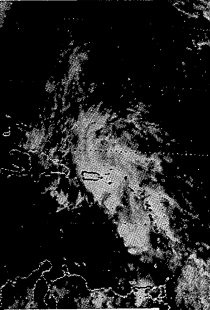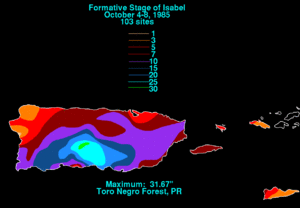1985 Puerto Rico floods facts for kids

Satellite image of the tropical system near Puerto Rico
|
|
| Date | October 1985 |
|---|---|
| Location | Puerto Rico |
| Deaths | 180 |
| Property damage | $125 million (1985 USD) |
The 1985 Puerto Rico floods were a terrible natural disaster. They caused the deadliest single landslide ever recorded in North America. This landslide killed at least 130 people in the Mameyes neighborhood of Ponce. The floods happened because of a weather system called a tropical wave. This system started near the coast of Africa on September 29. It moved into the Caribbean Sea by October 5. This brought very heavy rain to Puerto Rico. Some areas received over 31 inches (800 mm) of rain. Two weather stations even broke their 24-hour rainfall records from 1899.
The heavy rains caused severe flooding in the southern part of Puerto Rico. This cut off towns, destroyed roads, and made rivers overflow. Besides the deadly landslide in Mameyes, a bridge in Santa Isabel was washed away. This also caused several deaths. The storm system led to about $125 million in damage. It also caused 180 deaths. Because of this, the president declared it a disaster area. This same weather system later grew into Tropical Storm Isabel.
Contents
How the Storm Formed
The weather system that caused the flooding began near the west coast of Africa on September 29. It moved west and entered the eastern Caribbean Sea on October 5. However, rain had already started falling on Puerto Rico the day before. The storm had many thunderstorms, which became even stronger because of other weather patterns nearby. This system was actually starting to turn into a tropical cyclone as it moved over Puerto Rico.
When the storm's rainbands hit the mountains in southern Puerto Rico, they caused extremely heavy rainfall. The storm also moved very slowly, which meant even more rain fell over a longer time.
The heaviest rain happened on October 6. On that day, two places recorded more than 23 inches (580 mm) of rain in just 24 hours. These amounts broke the 24-hour rainfall records set during the 1899 San Ciriaco hurricane. The rain was so much that it was almost half of what those areas usually get in a whole year! The town of Peñuelas reported very high rainfall in a short time. For example, it got 2.75 inches (70 mm) in one hour and 5.5 inches (140 mm) in two hours. The highest total rainfall in Puerto Rico was 31.67 inches (804 mm) in Toro Negro State Forest. The southern half of Puerto Rico generally saw over 10 inches (250 mm) of rain. Even the United States Virgin Islands received over 7 inches (180 mm). This weather system later formed a low pressure area north of Hispaniola. This became Tropical Storm Isabel on October 7. The rains in Puerto Rico stopped a day later. Tropical Storm Isabel eventually hit Florida before it disappeared on October 15.
What Happened During the Floods
The heavy rains from this weather system caused rivers to flood and many landslides across Puerto Rico. The areas most affected were the towns of Ponce, Juana Díaz, Santa Isabel, and Coamo. Several places experienced what is called "100-year flooding." This means floods so big they are only expected to happen once every 100 years. This happened just five months after similar floods hit the island. The floods in May mostly affected the northern part of the island. The October floods mainly hit southern Puerto Rico. However, the town of Barceloneta was flooded in both events. Several rivers overflowed their banks. The Toa Vaca reservoir filled completely for the second time since it was built in 1972.
A flooded creek in Quebrada del Agua, near Ponce, tragically killed 16 people. The floodwaters also washed away the bridge over the Río Coamo near Santa Isabel. This was on the main highway between San Juan and Ponce. At least six cars drove into a dark, 35-foot (11 m) gap where the bridge used to be. This killed 29 people. Four of those who died were police officers trying to save a family from a car that was swept away. At least six bridges were destroyed across the island.
The floods left about 32,000 people without electricity. Some towns were completely cut off. The floods also shut down 11 water treatment plants and 13 sewage treatment plants. This left 16 towns temporarily without clean water. Across Puerto Rico, the floods damaged 1,700 houses and completely destroyed another 1,300. About 50,000 people had to leave their homes and go to shelters. The total damage was estimated to be $125 million (in 1985 money). In total, the floods killed 180 people across the territory. 150 of these deaths were in Ponce. Officials said this was the "worst disaster" on the island since Hurricane Donna in 1960.
Two landslides also happened near Peñuelas. These landslides damaged or destroyed 13 buildings.
The Mameyes Landslide
The very wet ground caused many mudslides across Puerto Rico. However, only one of them caused many deaths. This happened in the hillside community of Mameyes, which is part of Ponce. A huge landslide, called a "block slide," happened around 3:00 am local time on October 7. A large piece of rock and soil broke off a hill. It sent about 250,000 cubic yards (190,000 m³) of material rushing down the hill. The intense rainfall caused the landslide. But other things, like a leaky water pipe and poor drainage, probably also helped cause it. The landslide destroyed about 90 houses and killed around 130 people. Some estimates suggest the death toll could have been as high as 300. This made it the deadliest single landslide ever recorded in North America. Many homes in Mameyes were not built very strongly. They were made of tin and wood, and some were even built on stilts.
What Happened After the Floods
On October 7, Puerto Rico's governor, Rafael Hernández Colón, declared a state of emergency for the entire island. He called in 300 National Guardsmen to help with search and rescue. Governor Colón also asked for "technical advice" from Mexico. Mexico had just experienced a terrible earthquake two weeks earlier. The United States Coast Guard used helicopters to rescue people stuck in flooded areas. They rescued 18 people from a hill in the western part of the island.
Puerto Rico's government set aside about $10 million in emergency money. Of this, $1 million was given to the families most affected, with checks of $300 each. The American Red Cross sent a team of 15 people to Puerto Rico. These experts helped with things like checking damage and providing health services. After the storm, Puerto Rico's government created a Rainfall-Runoff Alert Network. This system was designed to help predict flash flooding in advance. They worked with the National Weather Service, the United States Geological Survey, and the territory's Department of Natural Resources.
On October 10, United States president Ronald Reagan declared 33 towns across Puerto Rico as disaster areas. This meant that federal money would be available to help families and to fix public buildings. The Federal Emergency Management Agency (FEMA) eventually provided $63 million in aid to Puerto Rico. Puerto Ricans living in the United States also raised money and collected donations for the people on the island.
Governor Colón thought about turning the Mameyes neighborhood into a common burial site to prevent health issues. Because of this, the National Guard evacuated the town. However, the governor changed his mind after many people protested. At first, reports said 500 people had died. But this number was later found to be too high. The number of destroyed houses was also first overestimated. These numbers were corrected after looking at satellite images from before and after the disaster and talking to survivors.
After the Mameyes landslide, about 150 people, including National Guardsmen, worked to find bodies. They had help from six rescue dogs. Rescue workers also found 23 bodies from the collapsed bridge near Coamo. On October 13, officials stopped searching for any survivors of the landslide. However, workers continued to look for other storm victims. On October 22, Governor Colón ordered the teams to stop searching for bodies. Officials decided there was a risk of more landslides. Workers had trouble helping the affected families at first because the landslide happened early in the morning and the rain was still very heavy. As a result, only 50 bodies were found. Many houses near the Mameyes landslide were later torn down because they were at risk of more landslides.
Governor Hernández Colón announced that a memorial would be built for the Mameyes victims at the site. It was first called "el Parque de la Recordación del Barrio Mameyes," which means "Park of the Remembrance of the Neighborhood Mameyes." But in 2011, people living in Ponce successfully asked to change the name from a park to a memorial site.
Even though many people died in the Puerto Rico floods, the name "Isabel" was not removed from the list of hurricane names right away. It was later removed after the 2003 Atlantic hurricane season.
Children's Drawings
Three days before the Mameyes landslide, a group of children from a nearby Head Start school were asked by their teacher to draw "whatever came to their minds." Several of them made drawings that some people believe were like predictions of the disaster. Some of the drawings showed crosses and dark, earth-like colors. Sadly, some of these children later died in the landslide. An unknown teacher gave the drawings to Gladys Torres, who manages public documents and is the Director of the Historic Archive of Ponce. These drawings are now shown at the Ponce Museum of History.



